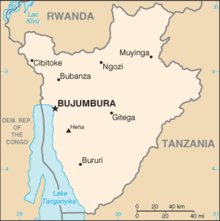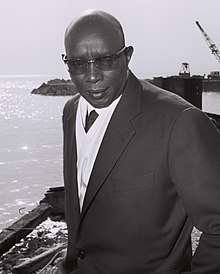1965 Burundian coup d'état attempt
On 18–19 October 1965, a group of ethnic Hutu officers from the Burundian military attempted to overthrow Burundi's government in a coup d'état. The rebels were angry about the apparent favouring of ethnic Tutsi minority by Burundi's monarchy after a period of escalating ethnic tension following national independence from Belgium in 1962. Although the Prime Minister was shot and wounded, the coup failed and soon provoked a backlash against Hutu in which thousands of people, including the participants in the coup, were killed. The coup also facilitated a militant Tutsi backlash against the moderate Tutsi monarchy resulting in two further coups which culminated in the abolition of Burundi's historic monarchy in November 1966 and the rise of Michel Micombero as dictator.
 | |
| Date | 18–19 October 1965 |
|---|---|
| Location | Bujumbura, Kingdom of Burundi |
| Type | Military coup |
| Cause |
|
| Motive | Regime change |
| Target | Royal Palace, Bujumbura |
| Organised by | Gervais Nyangoma Antoine Serukwavu |
| Participants | Faction within the Gendarmerie |
| Outcome | Coup fails
|
| History of Burundi |
|---|
|
|
Burundi 1962–present
|
|
Current
|
Coup
Background

In 1962, the Belgian mandate of Ruanda-Urundi received independence, creating the Republic of Rwanda and the Kingdom of Burundi. Both states had traditionally had monarchies dominated by the Tutsi ethnic group over a Hutu ethnic majority but Rwanda's monarchy was abolished by a political revolution in 1959–61. In the first years of independence, Burundi seemed to have achieved a balance between ethnic groups which brought members of the different ethnic groups into government, moderated in part by the mwami (king) Mwambutsa IV who was popular with all groups but was himself Tutsi. Both Tutsi, Hutu and Ganwa were part of the dominant political party, the Union for National Progress (Union pour le Progrès national, UPRONA).[1] In October 1961, shortly before the date scheduled for independence, the Burundian Prime Minister Prince Louis Rwagasore was assassinated, raising ethnic tensions in the country.[2][1] After a period of rule by Tutsi prime ministers, Mwambutsa appointed Burundi's first Hutu leader, Pierre Ngendandumwe, but Ngendandumwe was assassinated in January 1965 by a Rwandan Tutsi. Elections held in May 1965 took place in an atmosphere of strong ethnic tension. Hutu candidates gained a majority, but Mwambutsa deposed the Hutu Prime Minister Joseph Bamina and instead installed a Tutsi candidate, Léopold Biha, in October 1965.[1]
Coup and aftermath
The installation of Biha as Prime Minister created dissent between Hutus and the Burundian monarchy.[2] A group of Hutu officers in the army attempted a coup d'état against the Tutsi-led government on 18–19 October 1965.[3]
A small group of Hutu members of the Army and Gendarmerie marched on the Royal Palace. They were led by Gervais Nyangoma, a parliamentarian, and Antoine Serukwavu, a Gendarmerie commander.[4] Biha was shot and wounded.[1] The coup was foiled by troops led by the Tutsi military officer, Michel Micombero.[1] 34 Hutu soldiers who had been involved in the coup were arrested and executed. Hutus in the military and police who had not taken part were also arrested and many were killed. The coup's failure provoked immediate ethnic violence across the country in which thousands of people, mainly Hutus, were killed in what has been seen as a prelude to the Burundian genocide of 1972.[4]
As a result of the coup, Mwambutsa fled into exile and never returned to Burundi.[4] The failure of the Hutu military coup d'état created a Tutsi counter-reaction and laid the foundation for extreme Tutsi factions to seize power for themselves, first installing a new mwami and later abolishing the monarchy altogether in November 1966.[5] Micombero, later promoted to Prime Minister, would lead the second coup d'état and become Burundi's first republican President and de facto dictator until 1976.[4]
References
- Tshimba, David-Ngendo (21 January 2016). "2015 as a repeat of 1965 in Burundi: the stubbornness of political history". Thinking Africa. Retrieved 18 October 2016.
- Lemarchand 1995, p. 59.
- Lemarchand 1995, pp. 59-60.
- Bat, Jean-Pierre (17 May 2015). "Le premier coup d'État au Burundi (18 octobre 1965)". Libération (Africa4). Retrieved 18 October 2016.
- Lemarchand 1995, p. 60.
Bibliography
- Lemarchand, René (1995). Burundi: Ethnic Conflict and Genocide. New York: Woodrow Wilson Center Press. ISBN 0-521-45176-0.CS1 maint: ref=harv (link)
Further reading
- Mariro, Augustin. Burundi 1965: La 1ère Crise ethnique. Genèse et contexte géopolitique. Paris: L'Harmattan. ISBN 2-7475-9021-6.
